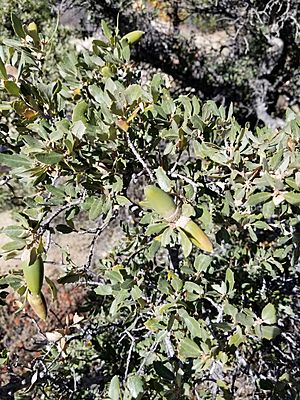Muller's oak facts for kids
Quick facts for kids Muller's oak |
|
|---|---|
 |
|
| Conservation status | |
| Scientific classification | |
| Genus: |
Quercus
|
| Species: |
cornelius-mulleri
|
Muller's oak (Quercus cornelius-mulleri) is a type of oak tree found in North America. People also call it Muller oak. Scientists officially named it a new species in 1981. Before that, it was thought to be part of another oak group. It got its name from a scientist named Cornelius Herman Muller, who studied nature.
You can find Muller's oak in southern California and Baja California. It grows in places like chaparral (a type of shrubland), oak woodlands, and mountain foothills. It's easy to spot in Joshua Tree National Park. You can also see it in the forests near the Colorado Desert in San Diego County, California.
What Muller's Oak Looks Like
Muller's oak is a bushy shrub. It usually grows up to 3 meters (10 feet) tall. It has many branches that grow close together.
Branches and Twigs
The twigs of Muller's oak can look tangled. They are gray, brown, or yellowish when they are new. As they get older, they become scaly.
Evergreen Leaves
The leaves of Muller's oak stay on the plant all year, so they are evergreen. They feel thick and leathery. The leaves have two different colors. The top side is a dull gray or yellow-green. It has a few tiny hairs. The bottom side is white and very fuzzy. This fuzz is made of tiny, star-shaped hairs. These hairs are joined together into small, flat shapes.
The leaves are oval-shaped. Their edges can be smooth or have small teeth. Each leaf is about 2.5 to 3.5 centimeters (1.0 to 1.4 inches) long.
Acorns and Fruit
The fruit of Muller's oak is an acorn. The cap of the acorn can be up to 2 centimeters (0.8 inches) wide. It is covered in light-colored scales. The nut part of the acorn is shaped like a cylinder with a round end. It can grow up to 3 centimeters (1.2 inches) long.
See also
 In Spanish: Quercus cornelius-mulleri para niños
In Spanish: Quercus cornelius-mulleri para niños



